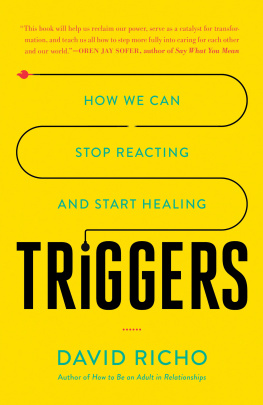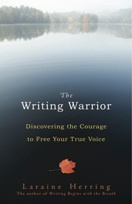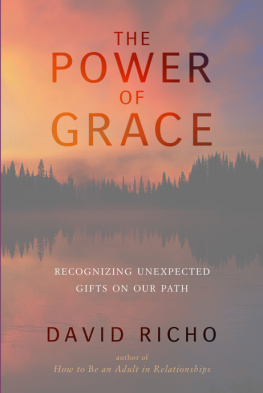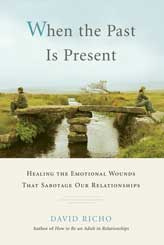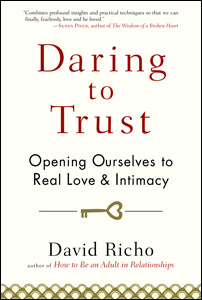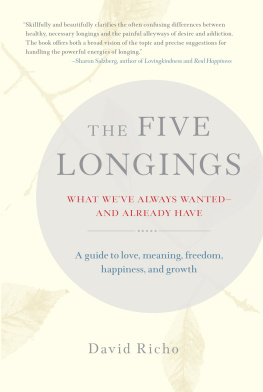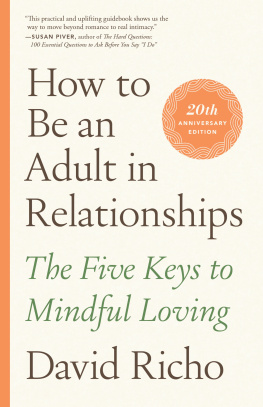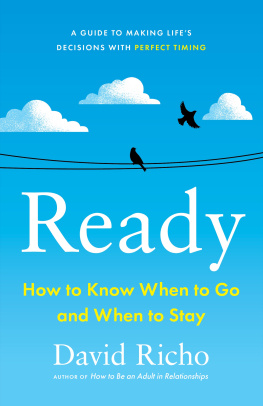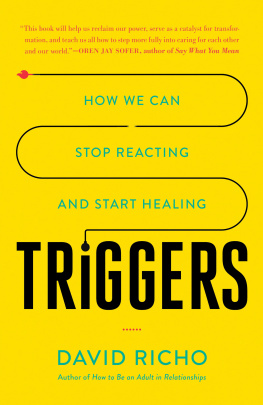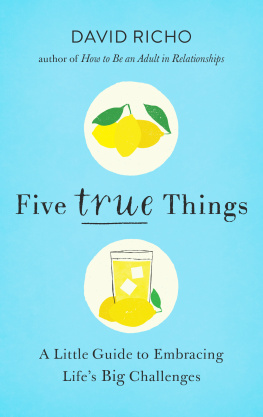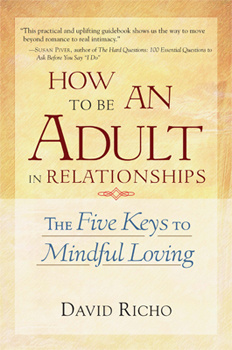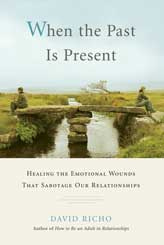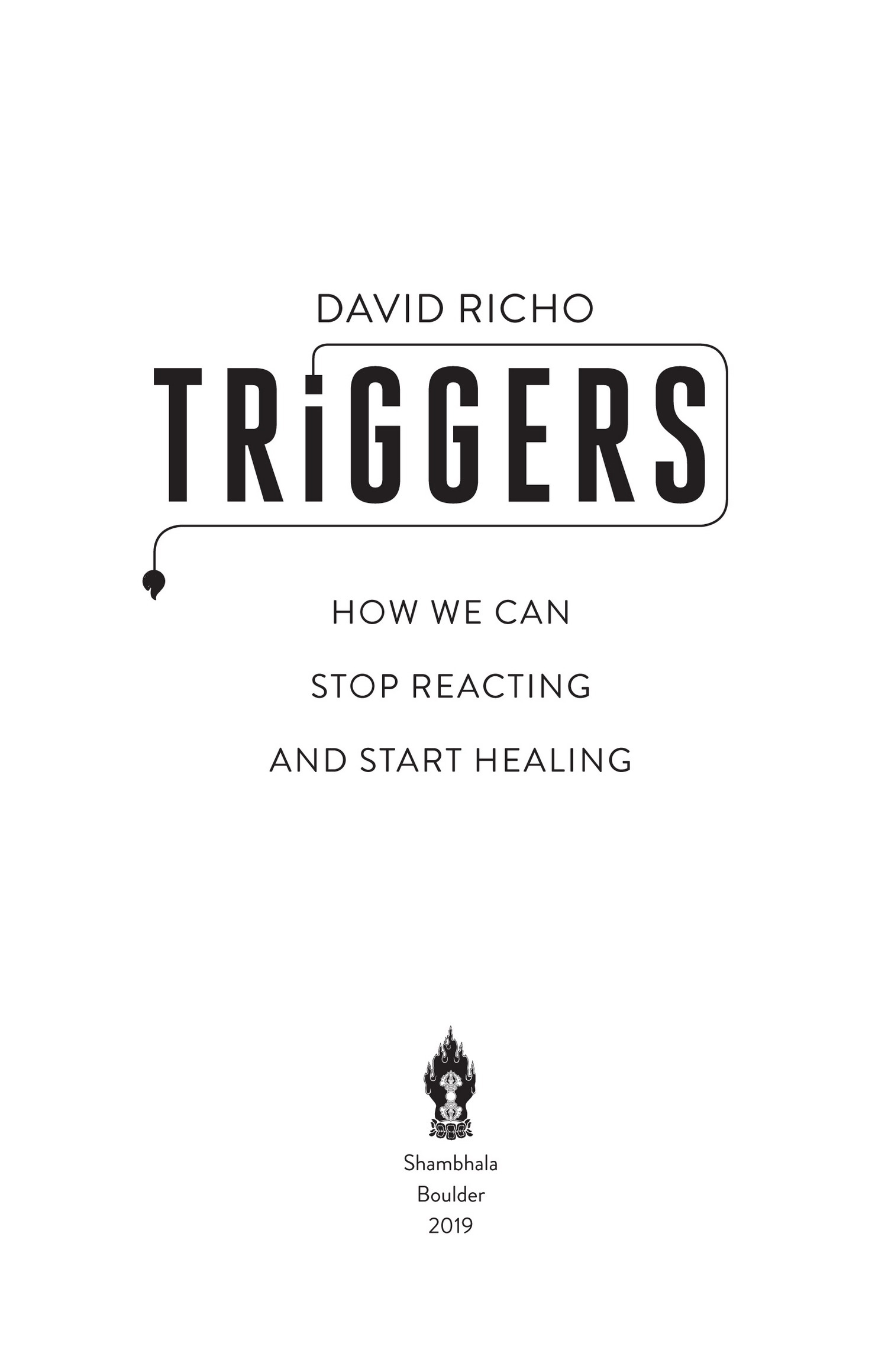Shambhala Publications, Inc.
All rights reserved. No part of this book may be reproduced in any form or by any means, electronic or mechanical, including photocopying, recording, or by any information storage and retrieval system, without permission in writing from the publisher.
Names: Richo, David, 1940 author.
Title: Triggers: how we can stop reacting and start healing/David Richo.
Description: First edition. | Boulder: Shambala, [2019]
Identifiers: LCCN 2019007666 | ISBN 9781611807653 (paperback; alk. paper)
Subjects: LCSH : Behavior modification. | Emotional conditioning. | Stimulus generalization. | Emotions.
Classification: LCC BF 637. B 4 R 53 2019 | DDC 155.9dc23
Walking with a friend in the dark is better than walking alone in the light.
INTRODUCTION
Someone says something to us, and we are suddenly struck with a sinking feeling in our stomach. Someone does something and instantly we become enraged or alarmed. Someone comes at us with a certain attitude and we go to pieces. We hear mention of a person, place, or thing that is associated with an unresolved issue or a past trauma and we immediately feel ourselves seize up with sadness, anger, fear, or shame. When any of this happens, we can be sure a trigger has been pulled. We find ourselves in a stimulus-response experience that happens to all of us. The stimulus is referred to in metaphorical terms, as either a trigger or a button: What she said triggered me, What he does pushes my buttons, I got hooked again. We might also say, I have a charge on this, using an electrical analogy.
A trigger is any word, person, event, or experience that touches off an immediate emotional reactionfor example, sadness, depression, anger, aggression, fear, panic, or humiliation, shame. Words, behavior, attitudes, events, even the presence of certain people, can incite reflex reactions in us over which we have no control. For example, we are suddenly surprised by a noise and we are startled. The noise is the stimulus/trigger; the startle is the reaction. Our reaction can be brief or long. Sometimes we can move through our reaction in a moment. Sometimes it becomes an obsession, hard to shake off. This disempowers us and plunges us into a sense of being unsafe and insecure.
Our reaction to a trigger is often excessive, larger than what is warranted by the stimulus, longer-lasting than what fits the triggering event. The extent to which a trigger affects us is proportional to how thick- or thin-skinned we are. The more sensitive we are to others behavior toward us, the more fiercely does our fear, anger, or shame erupt. As we become stronger, more self-assured, we notice that the arrows of others dont penetrate so deeply. In a wider context, regarding ourselves and society, we need to develop a thick enough skin to cope with our world and its shadow side rather than hide from it. Then we can face the onslaughts of our imposing world with courage to deal and heal. This book can help us do this. We can come to notice what triggers us and understand why. This is how we reclaim our power, have more choice about our immediate reactions, find healing from processing a trigger experience. When a trigger stays the night with us, lasts too long, it is a signal. There is something to look into, to deal with. For instance, someone at work has triggered us and it is keeping us up at night. We are finding out that we need to have a conversation with him, work the conflict out, speak up for ourselves. This is an example of how a trigger can beckon us to healthy assertiveness.
Our reaction is also based on our belief about how serious the trigger is. Examples of beliefs are assumptions, illusions, projections, suppositions. Our reaction moves from belief to expression first as a feeling and then sometimes with a follow-up of words or actions. Usually all this happens without our having a chance to consider what makes the most sense for us in the situation. Triggers and reactions happen so fast that we dont have a chance to pause, look at what is really happening, and make a wise choice. This is because triggers activate our limbic system, where the emotions reside, not our prefrontal cortex, where rational thoughts preside. We might say that the limbic system is like a horse, at times spirited, at times wild. The prefrontal cortex is like reins. We are the riders, with varying, but certainly improvable, levels of skill.
Trigger is an appropriate metaphor for what provokes these immediate reactions because the gun, the catalyst of our reaction, is in the hands of someone else. Using the button metaphoras in He pushes my buttonssuggests that someone does something and a nuclear reaction is set off in us. When the trigger is a hook, we are pulled into a reaction we regret or are angry at ourselves for biting it again. All three metaphors show how we lose our personal power. Someone or something has hijacked our equanimity, gained power over our feelings and actions. This is why triggers exaggerate our feeling, reaction, and belief about their meaning. All this is totally normal. Being triggered is not dysfunctional, though our reaction to a trigger might be.
In my work as a therapist and teacher I have heard clients and students talk about being triggered with increasing frequency in recent years. Some trigger experiences can be quite seriousfor example, a soldier with PTSD triggered by a sound that reminds him of combat, or a sexual assault survivor triggered by a touch that reminds her of her abuser. Other triggers may be connected to less-dramatic experiences, but peoples reactions still seem to take control over them. This book explores all kinds of triggers and reactions. I hope it will help you find greater understanding and relief, but it is important to note that some triggers and reactions are so deeply ingrained and powerful that working with a trained therapist may be an essential step in finding healing.
A person triggers us in direct proportion to how important he has become to us in reality or in our minds. For instance, someone we care deeply about may trigger us by showing any sign of abandoning us. Someone who threatens or scares us will easily trigger us, even when he does not intend to do so. Someone we have a crush on and obsess about will trigger us by almost anything she does. When we have given power to someone, we have placed his or her finger on a triggerand sometimes it is a hair trigger. But this does not mean that we should avoid caring about peoplerather, we can learn to understand and work with our triggers and reactions.
Sometimes a trigger can be immediate, here and now, with no earlier example of it. For instance, the first time we hear of a person in our family dying, we are stricken with grief and we weep. Usually, however, a trigger is a replay of an earlier experience. The original stimulus can be anything from a minor distress last year to a major trauma decades ago, especially in our childhood years. Those early experiences evoked grief that we have not yet fully felt or resolved. Thus, triggers can arouse post-traumatic stress that we wish to avoid. Yet, they also thereby give us a lively chance to recognize and mourn our losses, disappointments, and abuses. Indeed, every trigger is a catalyst for grief. Our sudden reactionfor example, sadness and chagrinis how we

